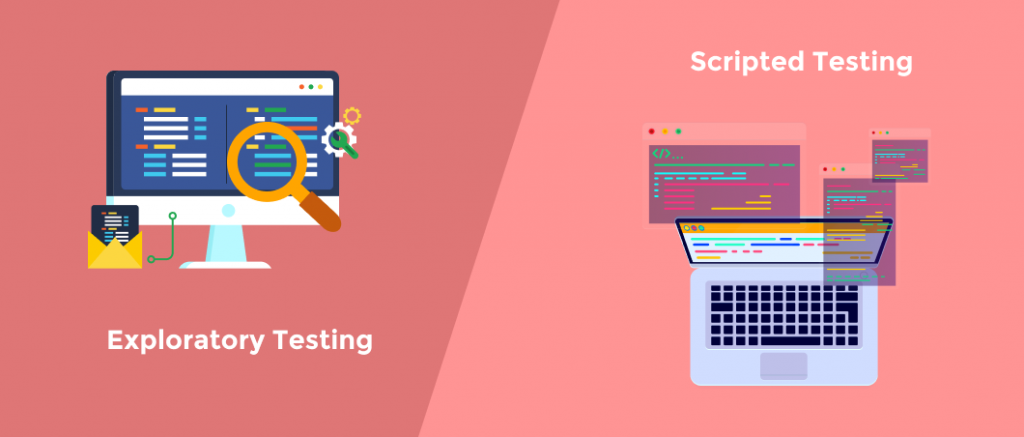Last updated on October 21st, 2024
Organizations use many methodologies and tools to test their product for bugs and issues. Most businesses follow pre-defined and time-tested approaches and tools to guarantee good quality. Then, there are those who put aside structure and processes for intuition and gut.
Software testing is an essential component of the software development lifecycle. Testing ensures that the software meets the desired quality standards and meets the needs of end-users.
There are two primary methods of software testing: exploratory testing and scripted testing. Both of these methods are crucial to ensuring software quality, but they differ in their approach, scope, and objectives. In this blog, we will compare exploratory testing with scripted testing, discussing the pros and cons of each approach.
So, what’s the real difference between the two methods? Which makes more sense?
What is Exploratory Testing?
Exploratory testing, a learning approach to software testing, emphasizes the personal freedom and responsibility of each individual tester. Exploratory testing can be applied to any test technique, at any stage in the development process. As the software is tested, individual testers may learn new things. This, when combined with their experience and creativity can drive new and improved tests that can enhance product quality.
The key aspect of exploratory testing is not the test technique being used or the product being tested, but the skills and experience of individual testers. Since exploratory testing is highly dependent on the tester’s skill in inventing test cases and detecting defects, the more skilled the tester, the better the outcome.
Pros of Exploratory Testing:
Flexibility:
Exploratory testing allows testers to adapt to the software they are testing, making it highly flexible. Testers can adjust their testing approach and techniques based on what they learn during testing.
Faster Feedback:
Exploratory testing provides rapid feedback to developers, allowing them to address issues as they arise.
Uncovering Hidden Issues:
Exploratory testing can uncover hidden issues and defects that scripted testing might miss.
Better Risk Assessment:
Exploratory testing helps testers to identify the high-risk areas of the software, allowing developers to focus their efforts on areas that are most likely to cause problems.
Cons of Exploratory Testing:
Requires Highly Skilled Testers:
Exploratory testing requires skilled testers who can adapt to changing testing conditions, making it difficult for less experienced testers.
Lack of Documentation:
Exploratory testing is often not well-documented, making it difficult to reproduce tests and ensure consistent results.
What is Scripted Testing?
Scripted testing requires testers to follow a detailed step-by-step approach to test a specific functionality. It requires testers to define test cases in advance with instructions that explain the expected results of the test. Testers must follow the steps. They have a clear idea about what should happen at the end of the test. Testers are clearly instructed to follow a sequence of steps with minimal deviation from the script. Scripted testing ensures that each and every piece of functionality is tested and passed. It confirms that all deliverables are met.
However, scripted testing is a time-intensive methodology; if the steps are too specific, they can become invalid or irrelevant with product evolution.
Pros of Scripted Testing:
Repeatable:
Scripted testing is repeatable, making it possible to verify that the software meets specific requirements consistently.
Predictable:
Scripted testing is predictable, making it possible to estimate the time and effort required to test the software accurately.
Well-Documented:
Scripted testing is well-documented, making it possible to reproduce tests and ensure consistent results.
Requires Less Skilled Testers:
Scripted testing requires less skilled testers than exploratory testing, making it more accessible for less experienced testers.
Cons of Scripted Testing:
Limited Flexibility:
Scripted testing is limited to the predefined test cases, making it less flexible than exploratory testing.
Misses Hidden Issues:
Scripted testing may miss hidden issues that exploratory testing would uncover.
Slow Feedback:
Scripted testing provides slower feedback than exploratory testing, making it more challenging to address issues as they arise.
Exploratory Testing vs. Scripted Testing
Although exploratory testing and scripted testing are clearly different, they aim for similar testing effectiveness. When performing exploratory testing, the expectations are open. While some results may be as predicted, others may not. When performing scripted testing, the test cases are designed in advance; all the testers need to do is compare the actual resulted with the expected result.
Here’s a comparison between the two approaches:
| No. | Exploratory Testing | Scripted Testing |
| 1 | Is more a mindset. | Is a formal testing methodology or approach. |
| 2 | Suitable when requirements and specifications are incomplete. | Suitable when requirements and specifications are complete. |
| 3 | Works well even if requirements or deliverables evolve. | Does not work well if requirements or deliverables change frequently. |
| 4 | Less preparation is needed to devise test cases. | Substantial preparation is needed to devise test cases. |
| 5 | Testers can use logical reasoning, based on previous results, to guide future testing. | Testers must follow step-by-step instructions and are not allowed deviations. |
| 6 | Extremely stimulating for the tester and they usually feel more involved in the process. | Since testers just have to follow guidelines, involvement levels are lower. |
| 7 | Bugs can be detected quickly. | Bugs are only detected at the end of the test cycle. |
| 8 | Works well if testers are pressed for time. | Does not work well with time constraints. |
| 9 | Dependent on the skills and abilities of the tester. | Independent of the skills and abilities of the tester. |
| 10 | Highly effective if testers are skilled as it gives them the flexibility to test as they build. | Highly effective if aspects or values that need to be checked are in a sequence. |
| 11 | Testers can alter tests on the fly. | Testers have to follow a sequence of test cases that have been designed in advance. |
| 12 | Enables rapid feedback. | Feedback is slower. |
| 13 | Since testing is performed on-the-fly, test cases cannot be reviewed in advance. | All test scripts and test cases are designed and reviewed in advance. |
| 14 | Since tests are unlikely to be exactly repeatable, new bugs or errors can emerge. | Since the same tests are repeated, chances of new bugs or errors being overlooked are higher. |
| 15 | There is no way to confirm that all the requirements have been met. | At the end of the testing cycle, testers can clearly confirm if all the requirements have been met or not |
| 16 | Managing test coverage is challenging. | Managing test coverage is easier. |
| 17 | Makes it difficult to identify the tests that have been run. | Detailed information on the tests that have been run is available. |
| 18 | Without documentation, repeating the same test can prove challenging. | Since all test scripts are defined in advance, the same tests can be repeated. |
| 19 | It cannot be automated. | It can be automated. |
| 20 | Testers do not know what to expect at the end of the testing cycle. | Testers know what to expect at the end of the testing cycle. |
Exploratory and Scripted Testing – Better Together
Clearly, scripted testing can only lead a tester to the desired result. It is not concerned about what is learned in the process -only that the desired result is achieved. Since this type of approach can severely limit learning in a testing environment, many potential problems that real-world users might encounter may never get caught by scripted testing. When combined with exploratory testing, however, the impact could be greater. By testing the product – beyond the script and driven by the testers’ skill and gut, testers can get fresh insights into product quality that scripted tests would have missed completely.
The main aim of any testing methodology is to ensure that the end product is bug-free. As we have seen, exploratory and scripted testing have their own benefits and drawbacks. Effective testing must be a combination of both approaches.
Get in touch with our experienced quality assurance team today to ensure that your software is thoroughly tested and ready to exceed user expectations!



